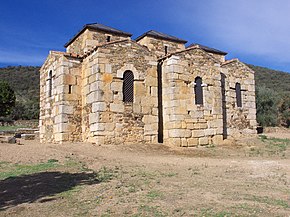Santa Lucía del Trampal
Santa Lucía del Trampal is a relatively well-preserved Visigoth church on the territory of the municipality ( municipio ) Alcuéscar in the western Spanish autonomous community of Extremadura . It is a three-apse church .
location
The small town of Alcuéscar is about 37 km (driving distance) north of Merida , not far from the border with Portugal at an altitude of about 460 m . The church of Santa Lucía del Trampal is located about 4 km south of the village near an old Roman road known as the Via de la Plata ("Silver Road"), which connected Mérida ( Emerita Augusta ) with Cáceres (Norba Caesarina) .
history
Probably in the 7th century - in some cases using stones of a Roman temple - built church originally had three naves with less than 1 m wide aisles, but mainly built of rubble nave collapsed at some point and was in the 14th or 15th century rebuilt in the simplest Gothic forms. Only a few fragments and five graves of the original building were discovered. In 1983/84 and 1989 excavations were carried out and the church restored. Over a dozen inscriptions were discovered that were dedicated to the goddess Atacaina ( equated by the Romans with Ceres or Proserpina ). They had entered the church with the reused building blocks of a temple , which also contained other evidence of Roman cults. Traces of the foundations of the Atacaina Temple were found at the eastern end of the church.
During the excavations, remains of the foundations of chambers were found on both sides of the nave , which were interpreted as monk cells and thus indicate that the church was part of a monastery. Similar finds were made at the churches of Santa María de Melque and San Pedro de la Nave .
architecture
The basic plan of the church is in the form of a dew-cross with three angular apses at the east end, which are separated from each other , a plan that is in the Byzantine tradition. A similar floor plan was chosen in the church of San Juan de Baños in Baños de Cerrato ( province of Palencia ). On the barrel-vaulted transept three small towers with wooden roofs rise; they are carried by horseshoe arches . There is a choir bay between the transept and the narrow nave . Since its renovation in the 14th or 15th century, the nave has been covered by a wooden gable roof resting on candle arches .
symbolism
The three spatially separated apses of the church with their also separate roofs have given rise to considerations, according to which the beliefs of the Visigoths adhering to Arianism , according to which the Trinity consists of three independent persons, are reflected in them . It can be countered, however, that the Visigoth king Rekkared I converted to Catholicism through his baptism in 587. In the years 603–610, the Visigothic ruler Witterich temporarily renewed Arianism in his empire, which then largely went under in the Visigothic empire .
See also
- Santa María de Melque in San Martín de Montalbán in the province of Toledo
- San Pedro de la Nave in Campillo near Zamora
- List of Visigoth architectural monuments in Spain
literature
- Jaime Cobreros: Guía del Prerománico en España. Madrid 2006, pp. 230-233.
- Oxford Archaeological Guides: SPAIN. 1998, p. 244.
Web links
- Santa Lucía del Trampal - floor plan, photos + description (Spanish)
- Santa Lucía del Trampal - floor plan, photos + description (English)
Coordinates: 39 ° 9 ′ 10.1 ″ N , 6 ° 13 ′ 21.5 ″ W.

